
Concept explainers
(a)
Interpretation: The product for the given reaction is to be drawn.
Concept introduction: Radical
The
Answer to Problem 31.50P
The product for the given reaction is,
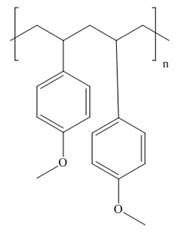
Explanation of Solution
The given alkene undergoes radical polymerization in presence of peroxide to form the
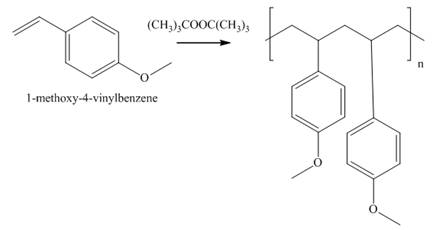
Figure 1
The product for the given reaction is shown in Figure 1.
(b)
Interpretation: The product for the given reaction is to be drawn.
Concept introduction: The reaction of an olefin with Ziegler-Natta catalyst leads to the formation of a linear and high molecular weight polymer. The components involved in Ziegler-Natta catalyst are
Answer to Problem 31.50P
The product for the given reaction is,

Explanation of Solution
The given alkene undergoes polymerization in presence of Ziegler-Natta to form the linear and high molecular weight polymer. The corresponding chemical reaction is shown below.

Figure 2
The product for the given reaction is shown in Figure 2.
(c)
Interpretation: The product for the given reaction is to be drawn.
Concept introduction: The anionic polymerization is a chain growth polymerization. Anionic polymerization takes place in alkene substituted with electron withdrawing groups and
Answer to Problem 31.50P
The product for the given reaction is,
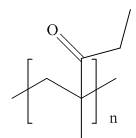
Explanation of Solution
The given alkene undergoes anionic polymerization in presence of

Figure 3
The product for the given reaction is shown in Figure 3.
(d)
Interpretation: The product for the given reaction is to be drawn.
Concept introduction: The cationic polymerization is a chain growth polymerization. This polymerization occurs in the alkenes with substituents which can stabilize the intermediate carbocation. This is an electrophilc addition reaction that involves the carbocations as intermediates.
Answer to Problem 31.50P
The product for the given reaction is,

Explanation of Solution
The given alkene undergoes cationic polymerization in presence of boron trifluoride in aqueous medium to form the polymer. The corresponding chemical reaction is shown below.

Figure 4
The product for the given reaction is shown in Figure 4.
(e)
Interpretation: The product for the given reaction is to be drawn.
Concept introduction: The anionic polymerization is a chain growth polymerization. Anionic polymerization takes place in alkene substituted with electron withdrawing groups and epoxides. In this polymerization the initiator is anion.
Answer to Problem 31.50P
The product for the given reaction is,
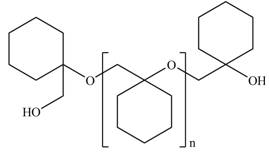
Explanation of Solution
The given epoxide undergoes anionic polymerization in presence base to form the polymer. The corresponding chemical reaction is shown below.
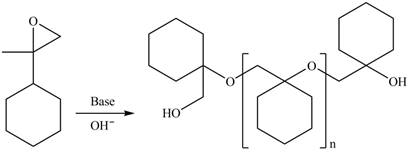
Figure 5
The product for the given reaction is shown in Figure 5.
(f)
Interpretation: The product for the given reaction is to be drawn.
Concept introduction: In Step-growth polymerization the monomers with different
Prepolymer which is composed of polymeric chain with epoxide rings at the each terminal and
Answer to Problem 31.50P
The product for the given reaction is,
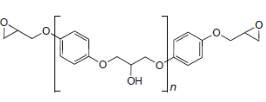
Explanation of Solution
The resorcinol undergoes step growth polymerization in presence of excess epichlorohydrin to form the polymer. The corresponding chemical reaction is shown below.

Figure 6
The product for the given reaction is shown in Figure 6.
(g)
Interpretation: The product for the given reaction is to be drawn.
Concept introduction: In Step-growth polymerization the monomers with different functional groups combine together to form the polymer with the loss of small molecule such as water. For example polyamides, polyesters, polyurethanes, polycarbonates and epoxy resins.
The polyesters are formed by the reaction of acid and alcohol as monomers.
Answer to Problem 31.50P
The product for the given reaction is,

Explanation of Solution
The given polyester on hydrolysis produces its monomers. The ester linkages are cleaved to produce alcohol and acid. The corresponding chemical reaction is shown below.
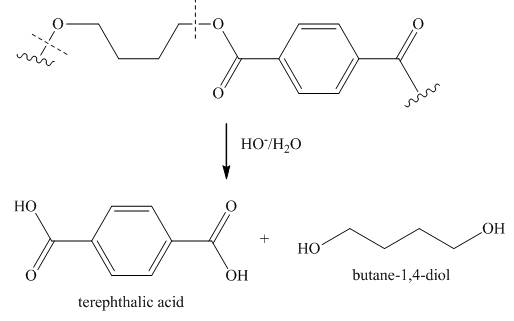
Figure 7
The product for the given reaction is shown in Figure 7.
(h)
Interpretation: The product for the given reaction is to be drawn.
Concept introduction: The reaction of monomer unit to produce a chain like or cyclic structure is known as polymerization. In some polymerization, ring formation takes place which are called ring-forming polymerization.
Answer to Problem 31.50P
The product for the given reaction is,
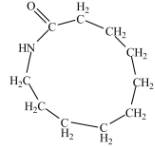
Explanation of Solution
The given compound reacts with base to form the cyclic polymer. The corresponding chemical reaction is shown below.

Figure 8
The product for the given reaction is shown in Figure 8.
(i)
Interpretation: The product for the given reaction is to be drawn.
Concept introduction: In Step-growth polymerization the monomers with different functional groups combine together to form the polymer with the loss of small molecule such as water. For example polyamides, polyesters, polyurethanes, polycarbonates and epoxy resins.
Polyurethanes contain carbonyl compounds bonded to
Answer to Problem 31.50P
The product for the given reaction is,
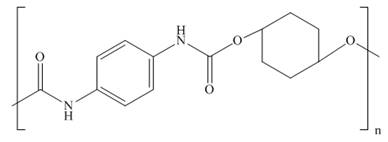
Explanation of Solution
The given diisocyanate reacts with the given
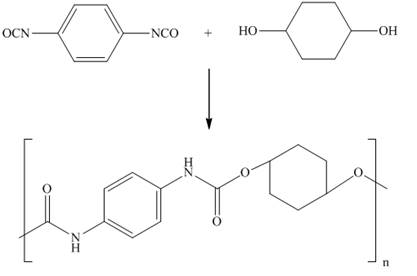
Figure 9
The product for the given reaction is shown in Figure 9.
(j)
Interpretation: The product for the given reaction is to be drawn.
Concept introduction: In Step-growth polymerization the monomers with different functional groups combine together to form the polymer with the loss of small molecule such as water. For example polyamides, polyesters, polyurethanes, polycarbonates and epoxy resins.
Polycarbonates contain carbonyl compounds bonded to two
Answer to Problem 31.50P
The product for the given reaction is,

Explanation of Solution
The given diol reacts with phosgene to undergo step growth polymerization to form the polycarbonate. The corresponding chemical reaction is shown below.
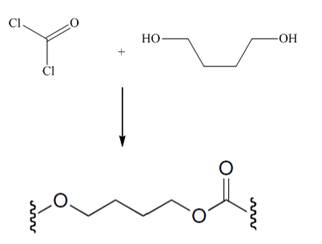
Figure 10
The product for the given reaction is shown in Figure 10.
Want to see more full solutions like this?
Chapter 31 Solutions
Organic Chemistry-Package(Custom)
- For each reaction below, decide if the first stable organic product that forms in solution will create a new C-C bond, and check the appropriate box. Next, for each reaction to which you answered "Yes" to in the table, draw this product in the drawing area below. Note for advanced students: for this problem, don't worry if you think this product will continue to react under the current conditions - just focus on the first stable product you expect to form in solution. NH2 CI MgCl ? Will the first product that forms in this reaction create a new CC bond? Yes No MgBr ? Will the first product that forms in this reaction create a new CC bond? Yes No G टेarrow_forwardFor each reaction below, decide if the first stable organic product that forms in solution will create a new CC bond, and check the appropriate box. Next, for each reaction to which you answered "Yes" to in the table, draw this product in the drawing area below. Note for advanced students: for this problem, don't worry if you think this product will continue to react under the current conditions - just focus on the first stable product you expect to form in solution. དྲ。 ✗MgBr ? O CI Will the first product that forms in this reaction create a new C-C bond? Yes No • ? Will the first product that forms in this reaction create a new CC bond? Yes No × : ☐ Xarrow_forwardPredict the major products of this organic reaction: OH NaBH4 H ? CH3OH Note: be sure you use dash and wedge bonds when necessary, for example to distinguish between major products with different stereochemistry. Click and drag to start drawing a structure. ☐ : Sarrow_forward
- Predict the major products of this organic reaction: 1. LIAIHA 2. H₂O ? Note: be sure you use dash and wedge bonds when necessary, for example to distinguish between major products with different stereochemistry. Click and drag to start drawing a structure. X : ☐arrow_forwardFor each reaction below, decide if the first stable organic product that forms in solution will create a new C - C bond, and check the appropriate box. Next, for each reaction to which you answered "Yes" to in the table, draw this product in the drawing area below. Note for advanced students: for this problem, don't worry if you think this product will continue to react under the current conditions - just focus on the first stable product you expect to form in solution. NH2 tu ? ? OH Will the first product that forms in this reaction create a new CC bond? Yes No Will the first product that forms in this reaction create a new CC bond? Yes No C $ ©arrow_forwardAs the lead product manager at OrganometALEKS Industries, you are trying to decide if the following reaction will make a molecule with a new C-C bond as its major product: 1. MgCl ? 2. H₂O* If this reaction will work, draw the major organic product or products you would expect in the drawing area below. If there's more than one major product, you can draw them in any arrangement you like. Be sure you use wedge and dash bonds if necessary, for example to distinguish between major products with different stereochemistry. If the major products of this reaction won't have a new CC bond, just check the box under the drawing area and leave it blank. Click and drag to start drawing a structure. This reaction will not make a product with a new CC bond. G marrow_forward
- Including activity coefficients, find [Hg22+] in saturated Hg2Br2 in 0.00100 M NH4 Ksp Hg2Br2 = 5.6×10-23.arrow_forwardgive example for the following(by equation) a. Converting a water insoluble compound to a soluble one. b. Diazotization reaction form diazonium salt c. coupling reaction of a diazonium salt d. indacator properties of MO e. Diazotization ( diazonium salt of bromobenzene)arrow_forward2-Propanone and ethyllithium are mixed and subsequently acid hydrolyzed. Draw and name the structures of the products.arrow_forward
- (Methanesulfinyl)methane is reacted with NaH, and then with acetophenone. Draw and name the structures of the products.arrow_forward3-Oxo-butanenitrile and (E)-2-butenal are mixed with sodium ethoxide in ethanol. Draw and name the structures of the products.arrow_forwardWhat is the reason of the following(use equations if possible) a.) In MO preperation through diazotization: Addition of sodium nitrite in acidfied solution in order to form diazonium salt b.) in MO experiment: addition of sodium hydroxide solution in the last step to isolate the product MO. What is the color of MO at low pH c.) In MO experiment: addition of sodium hydroxide solution in the last step to isolate the product MO. What is the color of MO at pH 4.5 d.) Avoiding not cooling down the reaction mixture when preparing the diazonium salt e.) Cbvcarrow_forward
 ChemistryChemistryISBN:9781305957404Author:Steven S. Zumdahl, Susan A. Zumdahl, Donald J. DeCostePublisher:Cengage Learning
ChemistryChemistryISBN:9781305957404Author:Steven S. Zumdahl, Susan A. Zumdahl, Donald J. DeCostePublisher:Cengage Learning ChemistryChemistryISBN:9781259911156Author:Raymond Chang Dr., Jason Overby ProfessorPublisher:McGraw-Hill Education
ChemistryChemistryISBN:9781259911156Author:Raymond Chang Dr., Jason Overby ProfessorPublisher:McGraw-Hill Education Principles of Instrumental AnalysisChemistryISBN:9781305577213Author:Douglas A. Skoog, F. James Holler, Stanley R. CrouchPublisher:Cengage Learning
Principles of Instrumental AnalysisChemistryISBN:9781305577213Author:Douglas A. Skoog, F. James Holler, Stanley R. CrouchPublisher:Cengage Learning Organic ChemistryChemistryISBN:9780078021558Author:Janice Gorzynski Smith Dr.Publisher:McGraw-Hill Education
Organic ChemistryChemistryISBN:9780078021558Author:Janice Gorzynski Smith Dr.Publisher:McGraw-Hill Education Chemistry: Principles and ReactionsChemistryISBN:9781305079373Author:William L. Masterton, Cecile N. HurleyPublisher:Cengage Learning
Chemistry: Principles and ReactionsChemistryISBN:9781305079373Author:William L. Masterton, Cecile N. HurleyPublisher:Cengage Learning Elementary Principles of Chemical Processes, Bind...ChemistryISBN:9781118431221Author:Richard M. Felder, Ronald W. Rousseau, Lisa G. BullardPublisher:WILEY
Elementary Principles of Chemical Processes, Bind...ChemistryISBN:9781118431221Author:Richard M. Felder, Ronald W. Rousseau, Lisa G. BullardPublisher:WILEY





